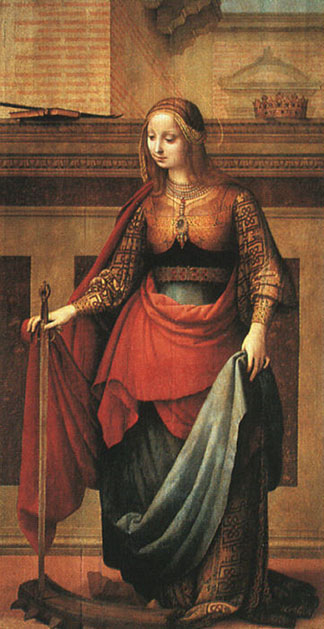Seleccionar idioma español/Choisissez la langue français

The story of Catherine of Alexandria has caught the popular imagination of many generations (she is, for example, one of the personages from whom Joan of Arc claimed to receive regular visits and messages), although most scholars judge it to be simply a work of fiction with no historical basis. It is said that Catherine was a Christian maiden of Alexandria in Egypt, possessed of beauty, brains, and noble birth. She rebuked the heathen emperor Maxentius for his idolatry, and he responded by offering to marry her if she would renounce her faith. She refused. Fifty philosophers were set to refute her in a public debate. She easily won every point, and made them look foolish. The emperor, a sore loser, had them burned alive. She was sentenced to be tortured on a spiked wheel, but the wheel flew apart and the fragments killed many of her accusers. After this and other marvels, Catherine was beheaded, and from her veins flowed not blood but milk. The angels carried her to Mount Sinai, where St. Catherine's Monastery is now located.
She is depicted carrying a spiked wheel, representing the manner in which it was proposed to put her to death. The "catherine-wheel," a form of fireworks that spins as it burns, is named for her.
Catherine is patron of preachers, philosophers, librarians (probably association with the Library of Alexandria), young girls, and craftsmen working with a wheel (potters, spinners, etc). The Mt. Sinai monastery was built by Justinian in 527, and has borne the name of Catherine since the eighth or ninth century. The monastery survives unmolested by the moslems (by express command of Mohammed) and has a vast but uncatalogued treasure of ancient manuscripts. One of the earliest known manuscripts of the complete New Testament, the Codex Sinaiaticus, was found there, borrowed by the finder, and never returned to the monastery. (I believe that it is now in the British Museum. [edit--actually, in four locations: the British Library, Leipzig University, St. Catherine's Monastery, and the National Library of Russia] Since then, they have been a bit crusty to visiting scholars.
written by James Kiefer